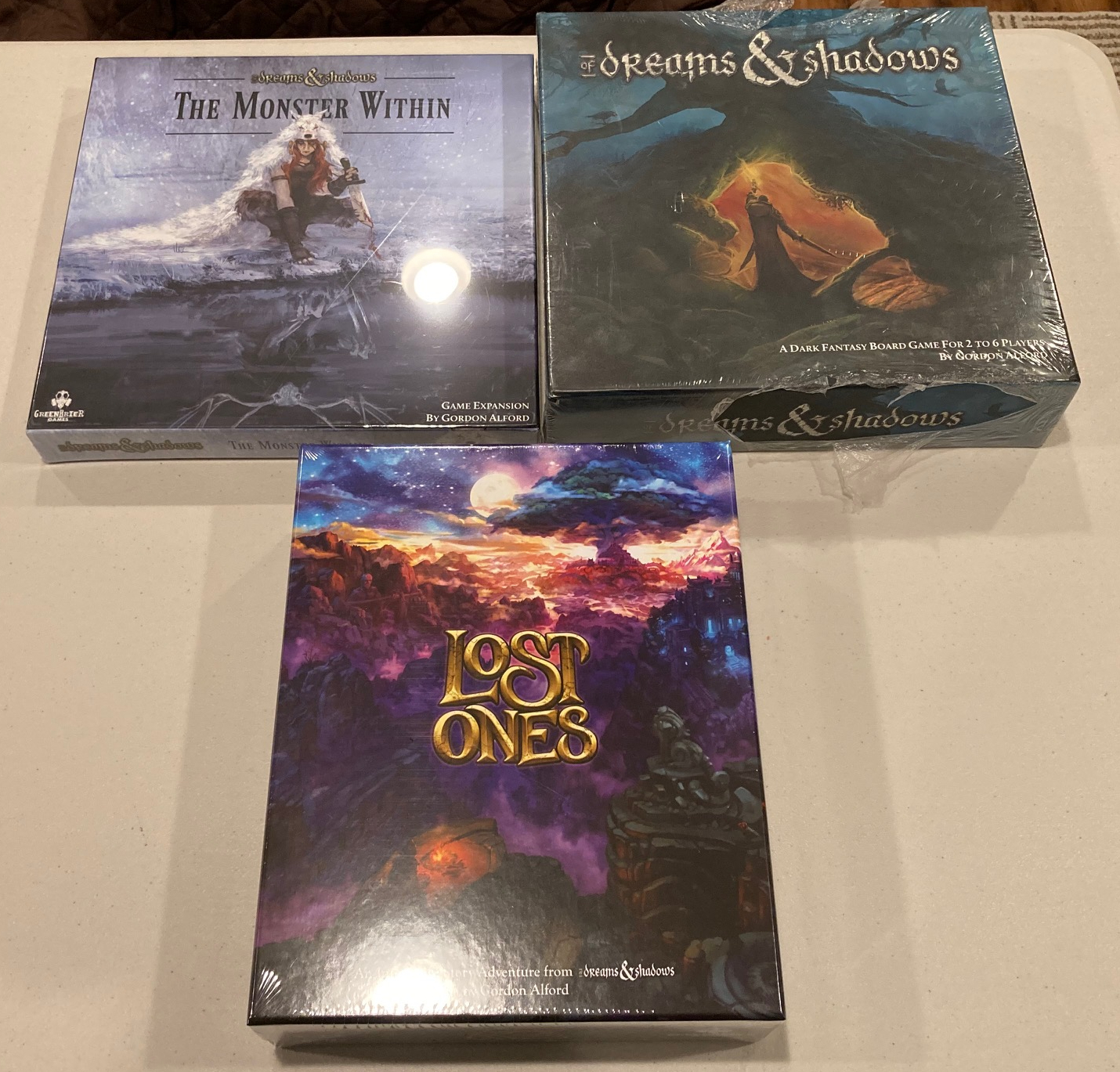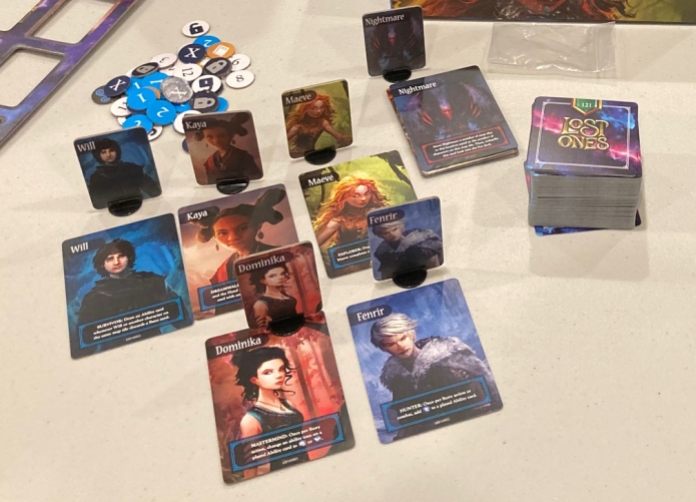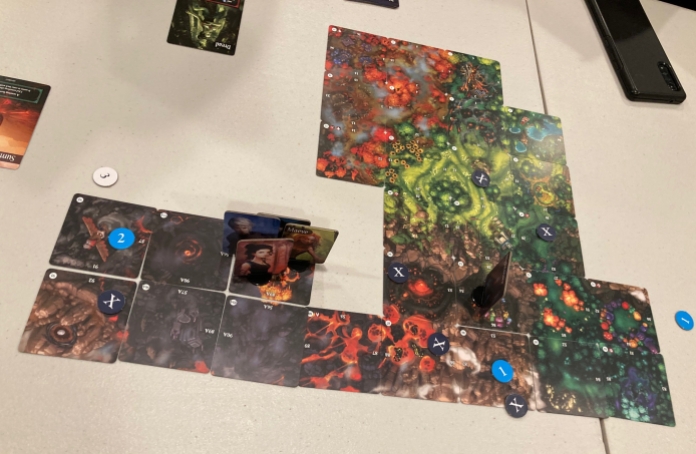
The Lost Ones was a cooperative game that was on Kickstarter back in November 2020. It just delivered to my house this week (January 22nd) after promising delivery in June 2021. I went in only on the base game, but there were also miniatures and an expansion for this game as well: we’ll just be looking at the base game here.
So, The Lost Ones bills itself as An Interactive Story Adventure from Dreams and Shadows (see above). What does that mean? The interactive story adventure part means this game fits into the cooperative Storybook Adventure games, as seen in our Top 10 Cooperative Storytelling/Storybook Games: these are games where a storybook (that comes with the game or app) helps guide the players through an adventure. The closest analogue would be The Choose Your Own Adventure books, where you read through a story and make choices, turning through pages in a book.

The world of The Lost Ones is the same as the Dreams and Shadows world:

Gordon Alford designed The Lost Ones and a previous cooperative game, Dreams and Shadows (which I have yet to play, but I do want to: I mean, they still have their shrink wrap!), See above. The Lost Ones seems to take place in the Dreams and Shadows universe.

As should be obvious from the back of the box (above), The Lost Ones (and Dreams and Shadows) is a fantasy universe. The Lost Ones plays 1-4 players, ages 14+, in about 90 minutes. That 90 minute time is very squishy, depending on how you play. Let’s take a look below.
Unboxing and Discussion

The Adventure Guide, the book at the top of the box when you open, is both a rulebook and a partial storybook.

Next in the box come the standees and tokens: see above. The standees and tokens are nice enough (apparently, there were miniatures for the deluxe version): the art in this game seems to be very consistent with the same art from the cover, which is saying a lot: that cover is pretty amazing!

Below all the books and tokens are the cards and the “little storybook”.

I call it “the little story book” because it’s kind of small! See the Coke Can above for comparison. One of the things that’s a little confusing is that there are two “text books”: the story book above, and the text blocks from the Adventurer’s Guide. We’ll talk more about this split later!

The square cards form the terrain of the game: this kind of reminds me of Tainted Grail (see Part I and Part II of our review) or The 7th Continent, with numbers on the edges refer to the adjacent tiles and form the map. Below is a partial preview (don’t look too close, or you might spoil some story): this map looks fantastic when set-up!

Players take the role of a character with individual powers, and each have a special card: see below.
The Nightmare (the black standee and card) will be a creature that follows the characters around the map: if The NIghtmare ever reaches a character, the game is over!

The core mechanism in the game for “getting stuff done” is the discarding of Ability cards: see a sample card (back and front) above. Through out the game, you will find challenges that need those icons to pass a challenge. For example, from the “little story book”:
In the storybook pages above, you can see two challenges, and a place to rest: in order to “pass a challenge”, you have to discard enough Ability Cards to read the text from the Adventure Guide. When you rest in the game, you can refill your hand of ability cards: there’s not a lot of other ways to get Ability Cards so they are a bit precious.

When do you actually pass a Challenge, you read from the guide: see some pages above. (The first half of the Adventurers’ Guide is rules, the second half is Adventure Choices). The choices you make are choosing which challenges to engage: these come from the Story Book. The results of your choices come from the Adventure Guide.

Of course, there are bad things that happen in the game: occasionally, you will explore a tile with a “Bane”: you flip a card from the Bane Deck and do what it says (always bad): See above!

To balance the Banes are the Boons: you get these as permanent rewards during the game: see above for a sample.

You also have to fight monsters/foes in the game: those come from yet another deck. Note that when my character explores the tile with the crossed swords, he has to immediately fight a monster! See Will hit card 27 with the crossed swords, so he gets to fight the Changeling! See above.
Overall, this game looks fantastic! A lot of the reason I backed this game was the art: the cover is just phenomenal, and all the art assets (especially the tiles when set-up) just look first rate. My only real complaint about the production is that the cards are NOT linen-finished. A stupid complaint (this is just me) is I that hate using the little “token notches” in the insert:

Recall that I had this problem is Disney Sidekicks as well: I find that token notches typically have the tokens come loose and cause them to wander in the box. Above, you can see I put all my tokens in a plastic bag so they won’t wander. This is probably just me.

Lost Ones looks beautiful.
Rulebook?

The Adventure Guide is an odd beast. You might be a little distressed when you see the length of the Adventure Guide: it’s 28 pages! See page 27 below (page 28, the back wasn’t marked).

The first half of the guide summarizes the rules, like a rulebook. The second half of the guide presents Adventure Choices, like a Storybook guide. Once you realize that, the 28 pages aren’t quite as daunting.

The game starts off with a table of contents. That’s nice, but I don’t think I ever looked at again after opening up the book. Honestly, I would rather have had an index to look up keywords: when we had questions when playing, certain indexed keywords would have more sense.

The Component List page (above) is nice: it let us easily correlate what we have. This worked great.

The Set-up worked fine: see picture above.



The rest of the rulebook did a “pretty good” job of explaining how the game flows, what the options are, icons, etc. The font was a little small, and the lack of index got in the way when we were playing (we looked up about 10 different things), but otherwise it was a pretty good rulebook for getting going and starting. Unfortunately, It wasn’t great ay answering edge case questions.

The Adventure Choice section was fine, but I thought the font was just a little small. Fine and easy to read otherwise.
Solo Play

So, congratulations to Lost Ones for following Saunders’ Law! Yes, there is a viable solo game contained within! Just like the base game, each player takes control of a single character, so the solo character only has to operate the one character. The only real change to the game (based on number of players) is hand size and how many Ability Cards each character starts with:

From there, the game play proceeds normally!
I really enjoyed Solo Play. It felt like I was reading a book, but with some choices (like a Choose Your Own Adventure book). And I just loved building and looking at the beautiful map. The game had a real simple flow: Move, Explore, Take Challenges. And it was just kinda fun to move through this world, as if I were moving through a book.
Cooperative Play
Cooperative play worked pretty well … at first. The game seemed to go off the rails, especially after we reset (see below). What happened was that a lot of the simplicity that seemed to shine playing solo didn’t quite translate to the cooperative game. In a 4-Player game (see above), there seemed to be too long to wait for your turn, too little to do on your turn (you only have three action points), and since the decisions are sometimes a little “arbitrary” (this a Choose Your Own Adventure type choices, so not necessarily deep), coming to a quorum seemed harder? Many times, it also wasn’t clear how the multiplayer rules interacted. (See reset later).

For example, poor Sara got stuck in the wilderness by herself and disengaged because she couldn’t leave the Fae Rings easily. We had almost 12 turns where she did nothing: we were trying to avoid dying again! If Sara moved, the Nightmare would activate and probably kill us. So, Sara didn’t move and took one for the team. But she didn’t have fun. We won because of Sara’s sacrifice, but it seemed at the cost of her having fun! We played “smart” and “munchkiny”, but at the cost of our friend’s enjoyment.
Reset

Without too much of a spoiler, you will probably die in your very first game. And it’s honestly expected. The game then directs you to reset and start again, retaining some of what your group has done/learned. This is a very cool and thematic idea, especially since there is some notion that “this is just a dream”! The problem is, what do you reset? See above as we reset from death!
After you die and have to reset, you have quite a bit of the map out! Does reset mean put the whole map away? And tokens? And cards? Strictly speaking, we interpreted the rules to mean “Yes, start the game completely from scratch!” … which means putting away the map and tokens! The problem is, that’s not fun. You have to sort the tiles, put them back in order in the stack, pick up the tokens, and start over! So, a ton of work. We chose to leave the map out for our second game because … it was less work and more fun.

But then that changes the game! With more tiles out, the Nightmare will move more slowly towards you, the rules about “Move vs. Explore” get fuzzy (All players can move together as a group, but the rules imply you can only explore as a single character), so we are cheating? Strictly speaking, probably, but we wanted the game to be fun, so we chose to keep the map out but reset everything else.
The rules REALLY needed to have a discussion on “What it means to reset”. The strict interpretation of reset is much less fun, but the more open interpretation of reset (“leave the map out”) way seemed unbalanced. The rules were very unclear and this disparity bothered us. Did we even play right after a reset?
Discussion
This game generated a LOT of discussion after we played. And I mean a lot! Some discussion was admiration of the art, some was suggested improvements, and some was actual complaints. Most of the complaints seemed to be about the ambiguity of the rules in the multiplayer game.
I originally sold my friends on Lost Ones as “this game was Tainted Grail with the story but without all the grind“. Recall from our review of Tainted Grail we liked it at first quite a bit (Part I), but we found the game too grindy even though we liked the story (Part II). And I expected my friends to love Lost Ones, because my friends loved the story in Tainted Grail but hated the grind! But, both me and my friends were surprised when we didn’t like it as much as we hoped. Why? We spent a fair amount of time talking about this: stuff we liked and stuff we didn’t:
- A lot of times, we would explore and spend resources to just “portent tiles”: the story we would read would suggest/imply certain things to do but without necessarily helping? In other words, we would “waste” resources to foreshadow what was on the next tile, which we visited next turn anyways. We didn’t love that part.
- We came to the conclusion that our group likes story with purpose: we really embraced Detective: City of Angels (see our review here) and Adventure Games: The Dungeon, both of which are on our Top 10 Cooperative Storytelling/Storybook Games. Although there is some interesting stuff that happens along the way in Lost Ones, for some reason, it didn’t engage us. And we think the world was too open for us? “Escape home”. That should have been a great purpose, right? Maybe it was too unguided? Maybe your group will love the more open world concept of Lost Ones, but my group(s) seem to want more direction.
- At first, we thought the world cards were too small. But after building the world and seeing how big it was, we concluded they did a fine job on that! Kudos! We just wished our standees were smaller!
- Edge Cases: this really killed us. Between my solo plays and our cooperative plays, there were SO MANY places where we had questions. The rulebook was decent to get into the game, but after we started playing, there seemed to be SO MANY QUESTIONS. See Questions section below. These questions kind of took us out of the scenario a little. Maybe that was part of why we disengaged a little?
- I liked the game more solo than cooperative. Maybe there’s just too much reading for a larger group?
- Why did we like Roll Player Adventures (RPA) so much more than Lost Ones? (RPA made our Top 10 Cooperative Games of 2021 and See our initial review here). We think it’s because the story in RPA was much more directed, but also RPA had a really good story!
We talked for some time after playing. We liked talking about the game! We thought it was okay, but we came to the conclusion it was probably best at a smaller player count.
Conclusion

Lost Ones game surprised me, but in the wrong direction. I expected my friends to really like the story here, but the game just went over “okay” in my group. The art was fantastic, and the simplicity of the system was very appealing, but the group play wasn’t as engaging as we had hoped. Some of this was the ambiguity of the rules took us “out of the game” a few times as we played.
Having said that, If you want a lighter “world exploration” and “interactive story” to explore solo or with a friend, I think I can recommend Lost Ones. I enjoyed this as a solo game: it was a light, fun, “read and explore” game… it was almost like reading a book with a really cool map? The group agreed Lost Ones would probably be better in a small group of one or two people: Teresa talked about playing with her Mom for fun, Sara suggested we played as a two-player game the next time we have a small group, and I mentioned how much fun I had a solo game.
Lost Ones isn’t an unconditional recommendation, but we did enjoy it, just not as much as we expected. It just seems best at 1 or 2 players.









You didn’t cover if solo play would also kill the fun by edge case questions
LikeLike